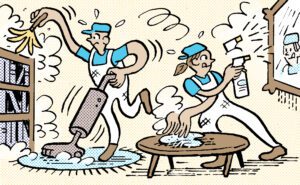 “Data-Driven Thinking” is written by members of the media community and contains fresh ideas on the digital revolution in media.
“Data-Driven Thinking” is written by members of the media community and contains fresh ideas on the digital revolution in media.
Today’s column is written by Bruno Gralpois, co-founder and principal at Agency Mania Solutions.
The growing number of brand advertisers setting up their own in-house agencies has grown exponentially in recent years. This phenomenon is often mentioned by industry analysts and agency leaders as a lead contributor to the financial pressure felt by agencies.
Advertisers often see their in-house agency as a viable solution to improve turnaround times, streamline internal communications, better leverage institutional knowledge, reduce costs and improve brand compliance, among the many benefits.
There have been well-publicized moves by large brands to strengthen their competencies by relying less on external agencies and taking more strategy and executional expertise in-house.
In the media category, Allstate, StubHub, Unilever and Netflix have all taken some media buying in-house. Unilever is also eliminating waste and driving more effective use of budgets. With zero-based budgeting, the brand squeezed $700 million from production costs in 2017 by making fewer ads and working through its in-house advertising agency, U-Studio; it reinvested half of the savings into media and in-store outlays.
Anheuser-Busch InBev moved programmatic in-house, claiming 25% savings in the US alone. The brand also created an in-house content production studio and moved social listening and analytics in-house.
The spirits maker Pernod Ricard also brought more digital expertise in-house, saving $71.5 million by purchasing 25% of its media in-house during the first half of 2017 and buying inventory directly from demand-side platforms.
Other recent in-house moves include Nationwide (programmatic), Target (influencer marketing and programmatic) and Jaguar Land Rover (analytics and programmatic). The list seems to go on.
To counter the growth of in-house agencies, some agencies are responding with their own solutions. For example, WPP digital agency Wunderman launched on-site unit Wunderman Inside to give advertisers such as Best Buy and Sainsbury’s nimble, cost-effective creative and strategic insights services without the potential trade-offs of in-house agencies.
It’s reportedly been a challenge for many brands to realize the benefits of their in-house agency model or hire top talent. Wunderman Inside provides clients with a mix of on-site specialists and in-agency resources. Advertisers don’t have to worry about hiring or training talent or having that expense sit on their payroll, but they still get the benefit of having these resources embedded within their teams.
This is what drove Oliver to also offer clients its external in-house resources, which it calls “better inside.” It builds dedicated agencies inside their client organizations with the right skills and capabilities, ranging from brand strategy, integrated marketing, content and community management, production and more.
In-house agencies are known to be nimble, cost-effective and well aligned to the brand and the strategic imperatives of the business, and they are on the radar of major brands trying to balance creativity, efficiency and outside perspective.
But often, the use of in-house agencies is limited to a few disciplines and the balance of the work is handled by the existing roster of external agencies. Look at United Airlines, which is moving video content creation in-house and handling creative content strategy and execution to complement the work it does with agencies like McGarryBowen and Wunderman. The roles and responsibilities are clear, avoiding confusion and resulting territorial issues.
At last year’s ProcureCon Marketing conference, I hosted a panel about how external and in-house agencies should collaborate in the years ahead. The feedback was unanimous: Brands want to see their in-house agencies – no matter the scale – collaborate with their external agency partners better.
To do so, they must set clear partnership goals and expectations, articulate what collaboration must look like and objectively and fairly measure the performance of all in-house or external agencies.
Neither in-house nor external agencies should operate independently – to the contrary. Finding the right balance of internal and external talent to build a top-notch performing organization is one of the CMO’s top challenges.
The collaboration of in-house and external agencies is an asset to advertisers looking to build highly effective teams. Together, they are simply stronger.
Follow Bruno Gralpois (@gralpois), Agency Mania Solutions (@agencymania) and AdExchanger (@adexchanger) on Twitter.












